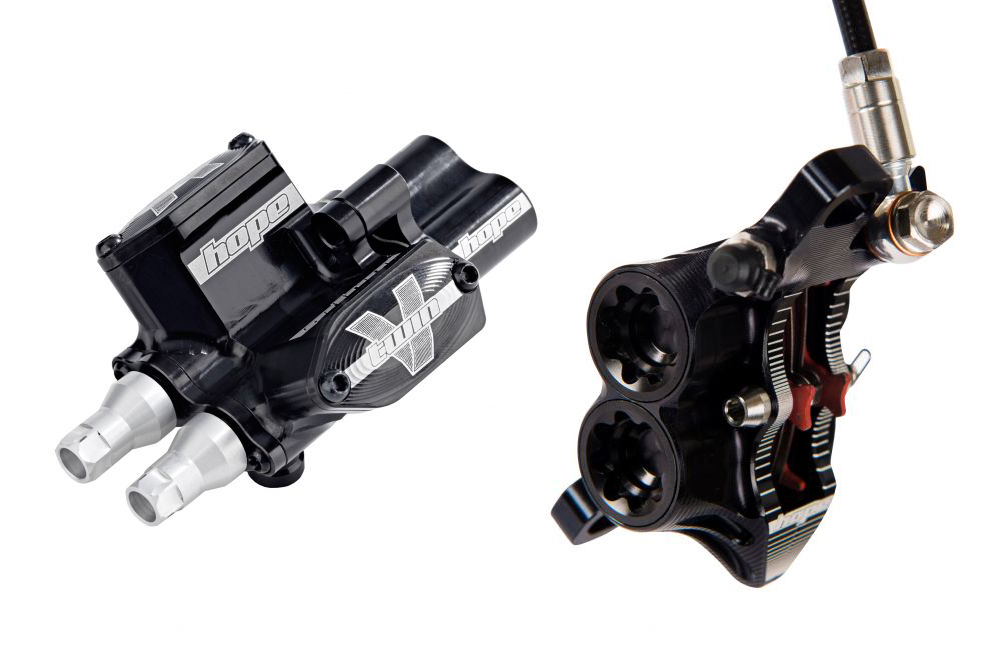Hope V-Twin hydraulic disc brake converter review
The Hope V-Twin converts cable operated brake levers to run hydraulic calipers. We've tested how it performs.

A useful way to upgrade your braking without going fully hydraulic, but the weight penalty and lower performance than full hydraulic options counts against it.
-
+
Improves braking over cable brakes
-
+
Can use secondary bar-top levers
- +
-
-
Relatively heavy
-
-
Braking not as good as a fully hydraulic system
-
-
A bit fiddly to set up
- -
You can trust Cycling Weekly.

Paul Oldham may not have had to do much braking when he won the 2015 Three Peaks Challenge cyclocross race, but when he did he used cable operated STI brake levers with bar top secondary levers and the Hope V-Twin hydraulic disc brake convertor to convert the cables to operate his hydraulic brakes.
>>> Disc brakes: everything you need to know
The Hope V-Twin sits on a bracket below the stem and accepts the cables from a cable brake lever at the front of the unit, with a pair of hydraulic lines coming out of the bottom and actuating the front and rear brake calipers. Running hydraulic lines rather than cables from the stem to the brakes means that there’s much less opportunity for cable stretch, better modulation with less sponginess and an increase in overall power.
Watch: what do the pros really think of disc brakes?
Setup is relatively straightforward, although it does require dismounting your stem to fit the converter bracket. The grub screws which hold the cables in place are quite fiddly though, and since the system comes pre-bled, you may not be able to feed the hoses through the bike’s existing cable runs: we had to resort to zip ties along the top tube. The V-Twin comes with Hope’s excellent brake rotors too, in 160mm diameter, which can be swapped out for your existing brake’s rotors.
>>> Road bike groupsets: a complete buyer's guide (video)
Once bedded in, braking performance is definitely a notch up on cable-operated disc brakes, although not quite up to the standard of Shimano and SRAM’s newer all-hydraulic systems. And there’s the rub: with excellent hydraulic brakes now available for dropped bar bikes, it may be more sensible to make the swap from mechanical disc brakes completely rather than install the Hope V-Twin as a half-way house option.
For more details visit Hope.

Thank you for reading 20 articles this month* Join now for unlimited access
Enjoy your first month for just £1 / $1 / €1
*Read 5 free articles per month without a subscription

Join now for unlimited access
Try first month for just £1 / $1 / €1
Get The Leadout Newsletter
The latest race content, interviews, features, reviews and expert buying guides, direct to your inbox!
Paul started writing for Cycling Weekly in 2015, covering cycling tech, new bikes and product testing. Since then, he’s reviewed hundreds of bikes and thousands of other pieces of cycling equipment for the magazine and the Cycling Weekly website.
He’s been cycling for a lot longer than that though and his travels by bike have taken him all around Europe and to California. He’s been riding gravel since before gravel bikes existed too, riding a cyclocross bike through the Chilterns and along the South Downs.
-
 'It can really push me along' - How a velodrome comeback is making Caleb Ewan faster on the road
'It can really push me along' - How a velodrome comeback is making Caleb Ewan faster on the roadAustralian says he'll "definitely" continue track work after rekindling passion
By Tom Davidson Published
-
 'I've worked a lot on my sprint' - Kristen Faulkner plots unpredictability on racing return
'I've worked a lot on my sprint' - Kristen Faulkner plots unpredictability on racing returnOlympic champion looking forward to "exciting challenge" of continuing to outfox bunch
By Tom Davidson Published
-
 'This is a fresh start' - Belgian rider returns to professional cycling after two year anti-doping ban
'This is a fresh start' - Belgian rider returns to professional cycling after two year anti-doping banShari Bossuyt to ride for AG Insurance-Soudal from June
By Adam Becket Published